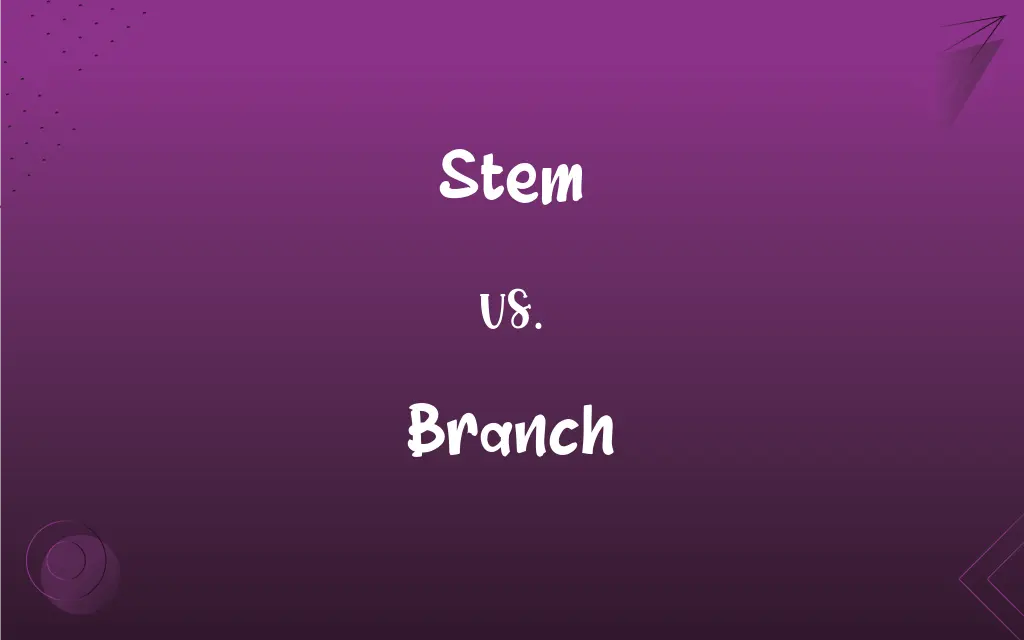Stem vs. Branch: What's the Difference?
By Janet White || Updated on March 4, 2024
A stem is the main structural part of a plant that supports leaves, flowers, and fruits and transports water and nutrients, while a branch is a secondary offshoot from the main stem, supporting leaves, flowers, and fruits on the plant's periphery.

Key Differences
The stem is a crucial component of a plant's anatomy, serving multiple vital functions. It acts as the primary support structure, holding up leaves, flowers, and fruits to ensure they receive enough sunlight for photosynthesis. A branch is a lateral extension of the stem, growing outward from the plant's main axis. It inherits some of the stem's functions on a smaller scale, providing support for leaves, flowers, and fruits and contributing to the plant's overall photosynthesis process by expanding its foliage spread.
The stem also houses the vascular system, comprising the xylem and phloem, responsible for transporting water, minerals, and nutrients throughout the plant. Branches enhance a plant's ability to capture sunlight and facilitate the efficient distribution of resources to various parts of the plant.
In stems, the central column can vary greatly in appearance and structure across different plant species, from the thick trunks of trees to the slender stalks of grasses. Its growth can be either upright, contributing to the plant's height, or horizontal, as seen in runners and rhizomes, which help in spreading and reproduction. In trees and many shrubs, the branching pattern significantly influences the plant's shape, appearance, and structural integrity. Branches can also play roles in reproduction and survival strategies, such as propagating new plants through cuttings.
Comparison Chart
Definition
The main central part of a plant that supports and transports.
A secondary offshoot from the main stem, supporting leaves, flowers, and fruits.
Functions
Supports the plant; transports water, minerals, and nutrients; stores food.
Supports leaves, flowers, and fruits; contributes to plant shape and structure.
ADVERTISEMENT
Growth Direction
Typically grows vertically from roots, forming the plant’s main axis.
Grows laterally from the stem, contributing to the plant's spread.
Structural Role
Central support structure for the plant.
Enhances the plant's ability to capture sunlight and spread its foliage.
Types of Growth
Can be upright, horizontal (runners, rhizomes), or climbing.
Determined by the plant's main stem and growth habits, varying widely among species.
Importance in Photosynthesis
Provides a platform for leaves and flowers for optimal sunlight exposure.
Increases foliage spread, enhancing the plant's photosynthetic capacity.
Stem and Branch Definitions
Stem
Can store food and water.
The potato plant's stem stores nutrients in underground tubers.
ADVERTISEMENT
Branch
Supports additional foliage.
The oak's branches spread wide, creating a broad canopy.
Stem
Facilitates growth and stability.
Tree stems, or trunks, provide the necessary strength to support large canopies.
Branch
A secondary extension of the stem.
Cherry tree branches are laden with blossoms in spring.
Stem
The main support and conduit for transport in plants.
The sunflower's stem grows tall to lift its flower towards the sun.
Branch
Influences plant health and productivity.
Fruit tree branches are thinned to increase air circulation and fruit quality.
Stem
Varies in form across species.
The bamboo's stem, or culm, is hollow, facilitating fast growth.
Branch
Contributes to the plant's shape.
Pruning the branches of a bonsai shapes the tree's aesthetic form.
Stem
Basis for the plant's structure.
The rose plant's stem is covered in thorns, offering protection from herbivores.
Branch
Can be used for propagation.
Willow branches easily root to form new trees when planted.
Stem
The main ascending part of a plant; a stalk or trunk.
Branch
A secondary woody stem or limb growing from the trunk or main stem of a tree or shrub or from another secondary limb.
Stem
A slender stalk supporting or connecting another plant part, such as a leaf or flower.
Branch
A lateral division or subdivision of certain other plant parts, such as a root or flower cluster.
Stem
A banana stalk bearing several bunches of bananas.
Branch
A secondary outgrowth or subdivision of a main axis, such as the tine of a deer's antlers.
Stem
The tube of a tobacco pipe.
Branch
(Anatomy) An offshoot or a division of the main portion of a structure, especially that of a nerve, blood vessel, or lymphatic vessel; a ramus.
FAQs
Are branches only found on trees?
No, branches can be found on a variety of plants, including trees, shrubs, and some herbaceous plants, contributing to their structural diversity.
What is the main function of a stem?
The stem's main functions include supporting the plant, transporting water and nutrients between roots and leaves, and sometimes storing food.
Why do some plants have many branches while others have few?
The number of branches a plant develops can depend on its genetic makeup, environmental conditions, and growth habits, tailored to optimize survival and reproduction.
What determines the direction of branch growth?
Branch growth direction is influenced by genetic programming, environmental factors like light and gravity, and the plant's overall growth strategy.
How does pruning affect stem and branch development?
Pruning can influence the plant's shape and growth patterns, encouraging denser foliage, more flowers, or fruits by stimulating new branch development.
What role do stems play in plant reproduction?
Stems support flowers and fruits, facilitate the spread of runners for asexual reproduction, and can store resources necessary for seed germination and growth.
Can a stem function without branches?
Yes, some plants, especially non-woody species and young seedlings, function and thrive without developing branches.
Can branches become new plants?
Yes, in many species, branches can root and grow into new plants, a process utilized in vegetative propagation techniques.
What is the difference between a stem and a trunk?
A trunk is a specific type of stem found in trees, characterized by its thick, woody structure that supports the tree's canopy and serves as the primary conduit for water and nutrients between the roots and leaves.
Why are some stems green and others brown or woody?
Green stems contain chlorophyll, allowing them to photosynthesize, and are typically found in younger plants or specific plants that rely on stems for photosynthesis. Brown or woody stems have developed secondary growth, providing structural support and longevity.
How do branches contribute to a plant's survival?
Branches increase a plant's foliage spread, enhancing sunlight capture for photosynthesis and supporting the plant's reproductive structures.
How do stems adapt to aquatic environments?
In aquatic environments, stems may adapt by becoming more flexible to withstand water currents, developing air-filled tissues (aerenchyma) for buoyancy and oxygen transport, or elongating to reach the water surface for light.
How do environmental factors like wind and light affect stem and branch growth?
Environmental factors such as wind and light can cause plants to adapt through mechanisms like phototropism and thigmomorphogenesis, leading to thicker stems or branches growing towards light sources and stronger structural adaptations to resist wind.
Can the absence of branches be beneficial to some plants?
Yes, in certain environments, such as dense forests or arid areas, the absence of branches can reduce resource competition or water loss, respectively, focusing growth on vertical height to access sunlight or conserving water.
What is the significance of branching patterns in plant identification?
Branching patterns, such as opposite, alternate, or whorled arrangements, are key characteristics used in plant identification, helping to distinguish between species and understand their evolutionary relationships.
How do stems and branches contribute to a plant's defense mechanisms?
Stems and branches can contribute to a plant's defense through physical barriers like thorns and bark or by transporting defensive chemicals that deter herbivores and protect against pathogens.
How does the structure of stems and branches affect a plant's health?
The structure determines the plant's ability to capture sunlight, support its weight, resist environmental stresses, and efficiently distribute resources, directly impacting its health and productivity.
What role do stems play in plant competition?
Stems play a crucial role in plant competition by elevating leaves and reproductive structures towards sunlight, enabling plants to outcompete neighbors for light resources and space.
Can all plants regenerate from stem or branch cuttings?
Not all plants can regenerate from cuttings. The ability to root from stem or branch cuttings varies among species and depends on factors like cutting technique, environmental conditions, and the presence of growth-promoting hormones.
How does climate change impact stem and branch growth?
Climate change can impact stem and branch growth by altering growth periods, increasing susceptibility to diseases and pests, and causing physiological stress due to changes in temperature, precipitation, and extreme weather events, potentially affecting plant structure and survival.
About Author
Written by
Janet WhiteJanet White has been an esteemed writer and blogger for Difference Wiki. Holding a Master's degree in Science and Medical Journalism from the prestigious Boston University, she has consistently demonstrated her expertise and passion for her field. When she's not immersed in her work, Janet relishes her time exercising, delving into a good book, and cherishing moments with friends and family.































































